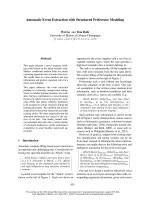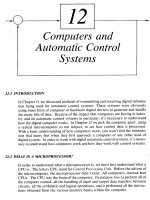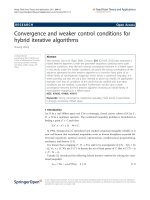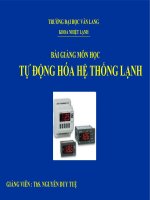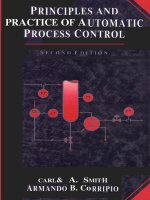vehicle automatic control subject project hybrid vehicle modeling
Bạn đang xem bản rút gọn của tài liệu. Xem và tải ngay bản đầy đủ của tài liệu tại đây (2.35 MB, 27 trang )
<span class="text_page_counter">Trang 1</span><div class="page_container" data-page="1">
<b>HO CHI MINH CITY UNIVERSITY OF TECHNOLOGY AND EDUCATIONFACULTY FOR HIGH-QUALITY TRAINING</b>
<b>VEHICLE AUTOMATIC CONTROL</b>
SUBJECT PROJECT
<b>HYBRID VEHICLE MODELING </b>
<b>Major: AUTOMOTIVE ENGINEERING Advisor: ThS. Nguyễn Trung Hiếu</b>
</div><span class="text_page_counter">Trang 2</span><div class="page_container" data-page="2">Ho Chi Minh City, 22 May 2023
<b>HO CHI MINH CITY UNIVERSITY OF TECHNOLOGY AND EDUCATIONFACULTY FOR HIGH-QUALITY TRAINING</b>
<b>VEHICLE AUTOMATIC CONTROL</b>
SUBJECT PROJECT
<b>HYBRID VEHICLE MODELING </b>
</div><span class="text_page_counter">Trang 3</span><div class="page_container" data-page="3"><b>Major: AUTOMOTIVE ENGINEERINGAdvisor: ThS. Nguyễn Trung Hiếu</b>
Ho Chi Minh City, March 2023
<small>THE SOCIALIST REPUBLIC OF VIETNAM</small>
<b><small>Independence – Freedom– Happiness</small></b>
<i><small>---Ho Chi Minh City, January 20, 2020</small></i>
<b>GRADUATION PROJECT ASSIGNMENT</b>
Student name: _________________________ Student ID: ___________________ Student name: __________________________ Student ID: ___________________ Student name: __________________________ Student ID: ___________________ Major: ________________________________ Class: ________________________ Advisor: ____________________________ Phone number: _________________ Date of assignment: _____________________ Date of submission: _____________
1. Project title: _________________________________________________________
2. Initial materials provided by the advisor: ___________________________________
3. Content of the project: _________________________________________________
4. Final product: ________________________________________________________
<b>CHAIR OF THE PROGRAMADVISOR</b>
</div><span class="text_page_counter">Trang 4</span><div class="page_container" data-page="4"><b><small>Independence – Freedom– Happiness</small></b>
<i><small>---Ho Chi Minh City, January 20, 2020</small></i>
<b>ADVISOR’S EVALUATION SHEET</b>
Student name: ... Student ID: ...Student name: ... Student ID: ...
Student name: ... Student ID: ...
</div><span class="text_page_counter">Trang 5</span><div class="page_container" data-page="5"><small>THE SOCIALIST REPUBLIC OF VIETNAM</small> <b><small>Independence – Freedom– Happiness</small></b>
<i><small>---Ho Chi Minh City, January 20, 2020</small></i>
<b>PRE-DEFENSE EVALUATION SHEET</b>
Student name: ... Student ID: ...Student name: ... Student ID: ...
Student name: ... Student ID: ...
</div><span class="text_page_counter">Trang 6</span><div class="page_container" data-page="6"><small>THE SOCIALIST REPUBLIC OF VIETNAM</small> <b>Independence – Freedom– Happiness</b>
<b>---EVALUATION SHEET OFDEFENSE COMMITTEE MEMBER</b>
Student name: ... Student ID: ...Student name: ... Student ID: ...
Student name: ... Student ID: ...
</div><span class="text_page_counter">Trang 7</span><div class="page_container" data-page="7">5. Mark:……….<i>(in words: </i>...)
<i>Ho Chi Minh City, month day, year</i>
<b>COMMITTEE MEMBER</b>
</div><span class="text_page_counter">Trang 8</span><div class="page_container" data-page="8"><b>THANK YOU</b>
During the course of doing the subject, we received a lot of help, suggestions, and enthusiastic guidance from teachers, family, and friends.
<b>We would like to express our sincerest thanks to Mr. Nguyen Trung Hieu, a </b>
lecturer at Ho Chi Minh City University of Technology and Education, who whole heartedly guided us throughout the process of doing this thesis. I also sincerely thank the teachers at Ho Chi Minh City University of Technology and Education for teaching and giving us knowledge about general and specialized subjects, helping me have a solid theoretical foundation, and facilitating support throughout the learning process. We are inspired to strive for the same level of success in all of our academic endeavors by their commitment to quality in the curriculum.
Finally, we would like to express our sincere thanks to our family and friends, who have always facilitated, cared for, helped, and encouraged us during the study and
<b>completion of the thesis. We also like to once more thank Mr. Nguyen Trung Hieu, </b>
the project committee’s chairt, for spending time to evaluate and review our project. Sincerely thank, you!
i
</div><span class="text_page_counter">Trang 9</span><div class="page_container" data-page="9">Hybrid electric technology has made great strides in the automotive sector in recent decades. Hybrid is now accepted as the best intermediate technology between traditional gasoline-powered cars and the upcoming all-electric cars. A hybrid electric vehicle (HEV) has traditionally been conceptualized as a combination of an electric generator and an internal combustion engine (ICE).
The ability of hybrid vehicle systems technology to dramatically improve fuel economy while meeting increasingly stringent emissions standards and driving requirements is its most important feature. To address both growing energy insecurity and global environmental problems, hybrid vehicles can be extremely important. In addition, hybrid technology has played a role in driving the advancement of electric motor technology.
Many control design goals are difficult to formalize, and many of the most important factors cannot be measured. Fundamentally, the management of the HEV system is also a matter of diversity given the large number of actuators, performance elements, and sensors. With multivariate designs, it is important to take advantage of these interactions; however, multivariable designs can make control methods less resistant to parameter fluctuations and uncertainties, making calibration more difficult. We will methodically look at control problems with HEVs in this volume, covering everything from design and performance analysis to motor structure and modeling.
With the desire to learn and study more closely about hybrid electric
<b>hybrid vehicles, our team has carried out the topic: HYBRID VEHICLE MODELING Matlab/Simulink application in mixed hybrid vehicle control simulation with guidance by Mr.Nguyen Trung Hieu</b>
During the research process, our team does not avoid shortcomings, we hope to receive help and guidance from teachers and friends.
ii
</div><span class="text_page_counter">Trang 10</span><div class="page_container" data-page="10"><b>1.3. Methods of the study...1</b>
<b>CHAPTER 2: HYBRID VEHICLE THEORY BASIS...2</b>
<b>2.1. Principle of operation of hybrid vehicle...2</b>
<b>2.4 Rate of use of motors and electric motors in each system...7</b>
<b>CHAPTER 3: SIMULATE POWER-SPLIT TRANSMISSION ON MATLAB/SIMULINK...8</b>
<b>3.1. Simulation diagram...8</b>
iii
</div><span class="text_page_counter">Trang 11</span><div class="page_container" data-page="11"><b>CHAPTER 1: TOPIC OVERVIEW1.1. Process overview</b>
Make the case:
The automobile market in Vietnam is growing in both quantity and design, model, and technology. Therefore, when looking to buy a car model, customers have more choices. In particular, the point of view of hybrid cars does not change the daily use of cars. This may be the point that many people like the most because there is no need to use external charging stations or ports to charge the battery. Hybrid vehicle users only need to fill up with gas and then use the vehicle and engine to explore while on duty supporting action transport while charging the vehicle's battery system. Not to mention the hybrid models also have a brake energy regenerative system that also greatly supports battery charging. Therefore, my group would like to choose the topic of simulating a hybrid car to survey the data.
<b>1.2. Accomplishment process</b>
+ Mastering the theoretical basis of the operating principle of this technology. + Control and run the model in accordance with the technology testing process. + Build a hybrid model on MATLAB/SIMULINK software.
Process limitations:
+ Simulation on software has not been implemented in reality.
<b>1.3. Methods of the study</b>
+ Use the theoretical basis of reference sources to build simulation models. + Calculate the necessary parameters for the model or refer to the available vehicle parameters in reality to conduct the simulation.
<b>1.4 Goals</b>
+ To better understand the working principle system of 3 types hybrid transmission, which can be applied to the design and control of other types of hybrid and electric vehicles
+
1
</div><span class="text_page_counter">Trang 12</span><div class="page_container" data-page="12"><b>CHAPTER 2: HYBRID VEHICLE THEORY BASIS2.1. Principle of operation of hybrid vehicle</b>
Hybrid vehicle works on the following principle: An electric motor is used to start the vehicle, which during normal operation it will operate synchronously. The electric motor is also used to enhance the power supply for the vehicle to accelerate or climb slopes. When braking or going downhill, the electric motor is used as a generator to charge the battery. Unlike other electric vehicles, the hybrid engine does not need an external power source, the internal combustion engine will provide power to the battery. With the combination of an internal combustion engine and an electric motor, a hybrid engine is an extended working limit, reducing fuel consumption for an internal combustion engine with high engine combination efficiency, large torque at rpm small rotation, and reduce environmental pollution.
<b>2.2. HEV classify2.2.1. Micro HEV</b>
As a vehicle with integrated start/stop technology, when the vehicle is in a completely stopped state, the engine is stopped and restarted as soon as the driver releases the brake pedal. Called a hybrid vehicle, but at this level of hybrid, the vehicle mainly still uses an internal combustion engine throughout the operation. This type typically operates at low voltages between 12V and 48V. Because of the low voltage level, the power capacity is usually less than 5kW. The biggest advantage of this type
2
</div><span class="text_page_counter">Trang 13</span><div class="page_container" data-page="13">of HEV is its low cost, while the downside is the inability to capture all the energy from regenerative braking. Fuel economy is 3-5%.
<b>2.2.2. Mild HEV </b>
At this level, the difference with the micro is that the electric motor now works with the internal combustion engine to optimize the engine's thrust. However, electric motors still cannot operate independently like internal combustion engines because the power of the motor is not enough to generate enough thrust to move the vehicle. It can be said that this is a hybrid vehicle similar to other conventional cars but equipped with a large capacity starter motor, which allows the car to stop the combustion engine while going downhill or stop and can restart it automatically. fast. Mild HEV uses an electric motor to support the internal combustion engine during acceleration and the ability to regenerate energy from regenerative braking during deceleration. Fuel economy is 15-20%.
<b>2.2.3. Full HEV</b>
It is the most powerful hybrid vehicle with a power output of 40kW and always operating at high voltages above 150V. The difference between this mild hybrid and the full hybrid is that the full hybrid vehicle is equipped with an engine block that is more compact enough to operate in full electric mode. Electronic components such as electric motors, alternators, and battery packs are much larger in size and performance than mild hybrids. The energy storage system is designed to be able to store the excess energy generated by regenerative braking under high-pressure working conditions. The fuel economy of this vehicle is up to 30%.
<b>2.2.4. Plug-in vehicles (PHEVs)</b>
Features common to all-electric hybrids and all-electric vehicles with the ability to charge the battery through AC (alternating) currently connected to the grid. The PHEV's powertrain typically produces 80-150kW of power, which allows the vehicle to use full-time electric mode for a range of 20-60 miles (or more than 30 to nearly 100km). The size of the internal combustion engine used in hybrid cars at this level is even more compact than on the full scale and obviously, the electric powertrain also has to be larger because of that, producing strong power. than the FHEV type. Like electric vehicles, PHEVs are also charged from the grid. During the journey, the vehicle uses electricity from the battery pack to start, when the battery pack is used to a
3
</div><span class="text_page_counter">Trang 14</span><div class="page_container" data-page="14">certain level, the car's internal combustion engine works to operate the vehicle while also recharging the battery pack and Energy storage from regenerative braking.
<b>2.3. Transmission method</b>
According to the transmission method, hybrid engines can be divided into 3 main types: series structure, and parallel structure power-split hybrid system.
<b>2.3.1. Series transmission</b>
Only one power converter can provide thrust. The internal combustion engine will participate in charging the battery pack when it is below the dischargeable voltage, in order to continue the journey. In a hybrid vehicle, the power required to drive the vehicle is the same as in an electric vehicle because the vehicle's thrust comes from the power of the electric motor. The electric drivetrain transmits thrust only to the rudder, and a generator set supplies electricity and power with a high-voltage current. Because of the simplicity of the dynamic control, this type of structure has many practical applications, especially in the medium-large truck series.
The advantages of this scheme are: The internal combustion engine will never operate in idle mode, thus reducing environmental pollution; The internal combustion
<i>Figure 2.2: Series transmission</i>
</div><span class="text_page_counter">Trang 15</span><div class="page_container" data-page="15">engine can be selected in the optimal operating mode, suitable for all types of cars; This scheme may not need a gearbox.
However, the series-coupled combination still has disadvantages such as: The size and capacity of the battery is larger than that of the parallel-coupled combination; Internal combustion engines always work in heavy mode to provide power for the battery, so they are easily overloaded. Today there are hardly any hybrid cars using this platform. However, this "oldest" platform is still being used in cars that use energy from Hydrogen fuel cells instead of using traditional gasoline engines to generate electricity.
<b>2.3.2. Parallel ransmission</b>
This is the simplest and least “expensive” Hybrid model, so it is applied quite a lot on cars.
Parallel Hybrid: For this type of system, both power sources (electric and gasoline) are connected directly to the wheels and can transmit power independently or simultaneously. Simply put, the wheel can be rotated separately by an electric motor or a gasoline engine, or both. Electric motors have two main functions. The first function is to convert the electrical energy supplied by the battery into mechanical energy. The second function is the reverse conversion of mechanical energy into electrical energy to recharge the battery. The current production of Hybrid Cars is designed this way because it is possible to utilize both energy sources in the most efficient way.
<i>Figure 2.3: Parallel transmission </i>
</div><span class="text_page_counter">Trang 16</span><div class="page_container" data-page="16">This scheme has the advantage that: The capacity of the car will be stronger due to the use of both energy sources, and there is no need to use a separate generator because the electric motor has a commutation, dual-use feature that will charge the battery. under normal operating modes, with little loss to intermediate actuators. The electric motor used here is a special type with a dual-use feature, it can start the internal combustion engine and use it as a generator to charge the battery, providing power in case the vehicle needs it. acceleration or uphill.
<b>2.3.4. Power-split transmission </b>
As its name says, this hybrid model is a combination of the two types mentioned above. It is the platform with the most complex structure and of course the highest production and cost.
This system combines the series system with the parallel system in order to maximize the benefits of the two systems. It has two motors and, depending on driving conditions, uses only the electric motor or the driving power from both the electric motor and the engine, in order to achieve the highest level of efficiency, the best fuel consumption, with The longest battery life and the highest peak speed compared to other platforms. Furthermore, when necessary, the system drives the wheels while simultaneously generating electricity using a generator.
<i>Figure 2.4: Power-split transmission </i>
</div>
